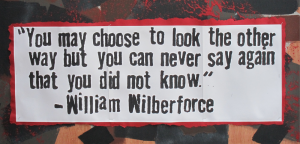Being college students, many of us can agree that the balances in our bank accounts are pretty limited. And as a result we’re always looking to save some money. We’ve all purchased a cheap item at Walmart or a dollar store and have been thrilled at the savings. But many of us don’t stop to think about the real cost behind it. Would you support the exploitation and abuse of a child through the forced labor industry? Or even the exploitation of adults? A majority of us would adamantly say no, we agree that it’s a morally corrupt practice. But we often fail to realize that we are doing just that when we purchase cheap goods. These cheap products are typically made in sweat shops by men, women, and children who have fallen victim to human trafficking. Not exactly what you thought when you saw that price tag, right?
I would never say that I support such an industry, but Anthony Talbott’s talk made me realize that I have indeed done exactly that. Many of us have by being uninformed consumers. This isn’t some small industry, either. Approximately 21 million men, women, and children have been trafficked and are victims of forced labor.1 Contrary to popular belief, many of these people are educated. They just find themselves in difficult times and are often lured in by the pretense of a stable job and necessities.2 They want to provide a better life for themselves or their families and so they accept the offer. They are often transported locally, nationally, or even internationally. When they arrive, despite the promises, they typically perform very tedious work for little to no pay under very poor conditions. Traffickers then use violence, coercion, debt bondage, and other tactics to keep victims from leaving.2 Traffickers are only in the business because they can make a large profit. With the global population increase, they can now purchase workers at very low costs. They then make a profit when the products that cost them virtually nothing to make are sold in the global marketplace. Forced labor provides an illegal yearly profit of approximately $150 billion.1 The profit is the main reason why traffickers are in the business, not because they personally have anything against the victims. Instead, they see an economic opportunity and thus find people who can easily be exploited. This is a human rights issue and a global problem. There are efforts in many countries to help end the trafficking taking place around the world, but unfortunately the victims are the ones being criminalized instead of the traffickers.
Anthony Talbott’s talk really opened my eyes on the topic of human trafficking, the modern day form of slavery. Sadly, this is not the only from of trafficking, but it was the one that I was least aware of. Talbott suggested being an informed buyer as a means to combat the issue. By knowing where our products are coming from we can avoid purchasing those made by forced laborers. An alternative option to purchasing more expensive products that were not made by forced laborers is to buy cheaper secondhand goods so at least workers aren’t re-exploited. By just taking a few minutes to educate ourselves on where our merchandise is coming from we can make a difference.
- “Forced Labour, Human Trafficking and Slavery.” International Labour Organization. Web. 26 Oct. 2014. <http://www.ilo.org/global/topics/forced-labour/lang–en/index.htm>
- “Human Trafficking.” Polaris. Web. 27 Oct. 2014. <http://www.polarisproject.org/human-trafficking/overview>
